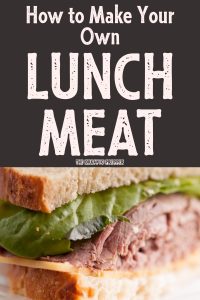You read about it in Dear Diary, It’s Me, Jessica: Part 9. Here at the OP, we don’t just talk the talk, we walk the walk! Let me show you how you too can make your own lunch meat at home!
As we all know, inflation is hitting everyone in their pocketbooks. A few years ago, a pound of deli roast beef was going for $6.99 for the store brand and the top shelf brand was going for $9.99 a pound. Now, the store brand is going for $14.99 a pound! I don’t even want to think about what the top shelf stuff is going for. Another thing I noticed was in the pre-sliced grab-n-go case, the deli meats and cheeses are being sold in half pound portions rather then the pound they were previously. I have even read news reports some people on the lower end of the socio-economic scale were skipping meals just to make ends meet.
Meat Selection and the Power of Salt
I checked the meat case for a cheap cut of meat. Surprisingly, I found a chuck roast for $4.99 a pound. In the past, eye of round has been at or about that price, but this week, eye of round was going for $6.99 a pound. I selected a 2.59 pound chuck roast with a fat cap on one side.
Using the book Charcuterie, The Craft of Salting, Smoking and Curing by Michael Ruhlman and Brian Polcyn, (I highly recommend this book!) I made a basic brine. Brining meat does three things:
1) It changes the meat cells at the molecular level, allowing the cells to plump with water, thereby making the meat moist. You can do the same thing with turkey to prevent it from drying at Thanksgiving dinner. I have done that in the past.
2) It infuses whatever seasoning or flavors you want to add. I made the above-mentioned Thanksgiving turkey with an Earl Grey tea infusion. It turned out great!
3) The salt acts as a preservative, preventing bacteria from forming in the short term, more so than unbrined meat.
The basic brine is:
- 1 gallon/4 liters of water
- ¾ cup/200 grams of kosher salt
- ½ cup/125 grams of sugar
I took half a gallon of water, put it in a bowl, and put it in the freezer to chill while I made the brine.
The other half a gallon of water, I put into a large saucepan, mixed in the salt and sugar, and brought it to a boil, occasionally stirring until all the salt and sugar dissolved. While the brine was coming up to a boil, I took a whole head of garlic cloves, peeled and smashed with the flat of a chef’s knife, and a whole onion sliced thinly. I turned off the brine after it came to a boil, added the garlic and onion, covered it, and let it sit for an hour.

I then put the meat in a 2.5-gallon plastic zip-lock bag and add the chilled water, then the garlic and onion-infused brine. Secure the bag and place it into the fridge for five days. I used the Charcuterie book’s guideline for corned beef as a reference for how long it takes to brine. On day five, I drained and discarded the brine, rinsed the meat, then put it into a bowl and covered it in the fridge to let the brine-infused meat rest and allow the salt to distribute into the meat.
The next day, I pulled the meat out for at least an hour prior to cooking to come to room temperature.
I used about half a head of garlic cloves, peeling and smashing them with a knife. I put them into a glass ramekin and added just enough olive oil to cover the cloves. Cover the ramekin with tin foil and bake at 400 degrees for thirty minutes. Let cool. Once cool, in a mixing bowl, add the garlic-infused oil, two table spoons of dried basil, oregano, thyme, and black pepper to taste, and mix well.
Pre-heat the oven to 300 degrees.
Heat a cast iron pan over high heat. When the pan begins to smoke, add a high smoke point oil like safflower oil, grape seed oil, or another neutral-tasting high smoke point oil. Once the oil is shimmering, add the meat and sear until a well-formed crust forms, rotating each side. Use a splatter screen—you will need it! Once seared, pull aside and allow to cool to handle with your hands.
Then, smear the garlic and oil herb mix all over the meat. Place the meat into the cast iron pan and roast in the oven for two hours for rare, two and a half hours for medium rare.
How Did It Come Out?
In a word, awesome!
On the front end, slap upside the head with the garlic, onion, and herb mix. On the back end, just a hint of salt.
I cut the roast up into three portions, freezing two and keeping the third in the fridge for sandwiches.
Next up, cajun roasted turkey breast. Might wrap and roast it in bacon just for fun!
Have you ever made your own lunch meat? What process did you use? Is this something you’d consider doing to save money?
Let’s discuss it in the comments section.
About 1stMarineJarHead
1stMarineJarHead is not only a former Marine, but also a former EMT-B, Wilderness EMT (courtesy of NOLS), and volunteer firefighter.
He currently resides in the great white (i.e. snowy) Northeast with his wife and dogs. He raises chickens, rabbits, goats, occasionally hogs, cows and sometimes ducks. He grows various veggies and has a weird fondness for rutabagas. He enjoys reading, writing, cooking from scratch, making charcuterie, target shooting, and is currently expanding his woodworking skills.
The post How to Make Your Own Lunch Meat appeared first on The Organic Prepper.
https://www.theorganicprepper.com/make-lunch-meat/
 CampingSurvivalistHuntingFishingExploringHikingPrivacy PolicyTerms And Conditions
CampingSurvivalistHuntingFishingExploringHikingPrivacy PolicyTerms And Conditions
